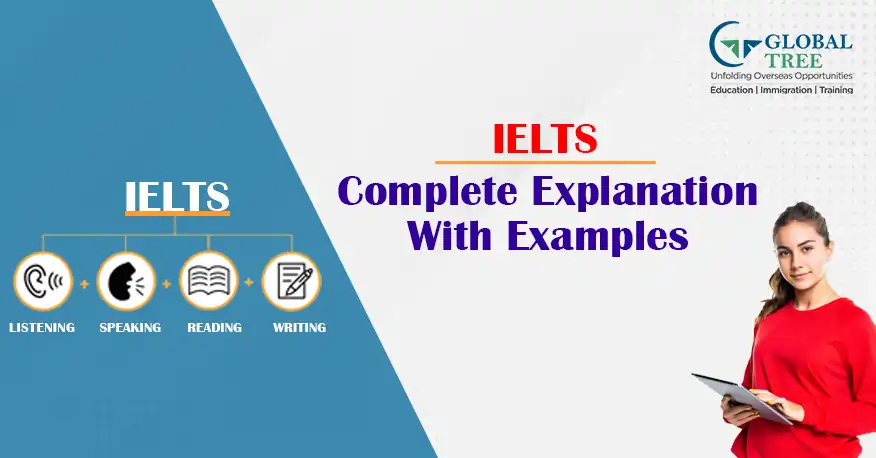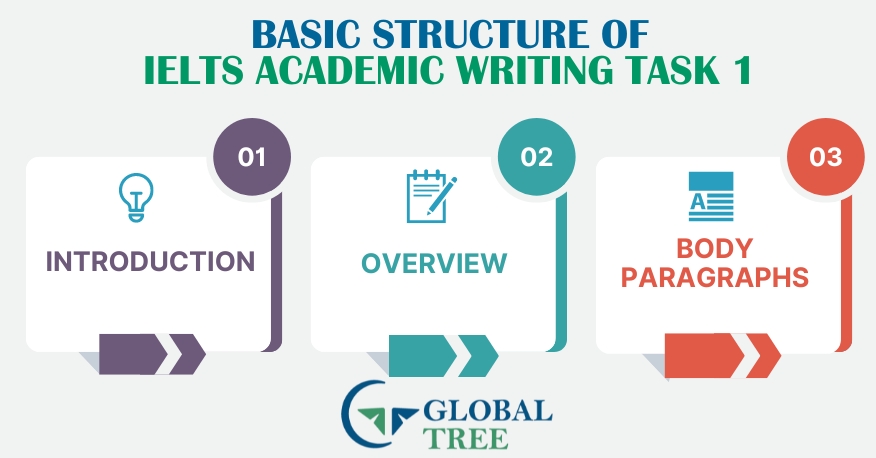IELTS Task 1: Complete Explanation With Examples

IELTS Test format Explained:
IELTS Academic and IELTS General Training are the two examinations available. Both tests are graded identically.
The first three components of the test will be taken on the same day, in the following order: listening, reading, and writing (no gaps between these tests). Depending on local arrangements, your Speaking test will be held on the same day or seven days before or after.
Writing for IELTS: THE FORMAT
The IELTS Listening test is designed to assess a wide range of listening skills, including how well you
- comprehend key concepts and in-depth details
- recognize a speaker's beliefs, attitudes, and purpose
- track the progression of an argument
- Format: You will listen to four recordings of native English speakers and then respond to a series of questions in writing.
- Recording 1: a talk between two people in a social setting.
- Recording 2: a monologue put in a common social environment, such as a speech about local amenities.
- Recording 3: a conversation between up to four individuals in an educational or training situation, such as a university instructor and a student talking about an assignment.
- Recording 4: an intellectual discourse, such as a university lecture
- Timing: The IELTS Listening test takes approximately 30 minutes, and you are allowed an extra 10 minutes to transfer your answers from your question booklet to your answer sheet.
- Number of Questions: 40 questions
- Task Types: A variety of question types are used, chosen from the following: multiple choice, matching, plan/map/diagram labelling, form/note/table/flow-chart/summary completion, sentence completion.
- Marks: Each correct answer receives one mark. Scores out of 40 are converted to the IELTS 9-band scale. Scores are reported in whole and half bands.
Know the IELTS exam Syllabus before applying
Highlights of IELTS Task-1
1. IELTS recommends that you devote no more than 20 minutes to writing task 1. However, you have complete control over the time.
2. You have to put together more than 150 words.
3. IELTS writing task 1 accounts for approximately 33% of your overall writing marks
4. You will be marked on:
1. Task Achievement (25%)
2. Coherence & Cohesion (25%
3. Vocabulary (25%)
4. Grammar (25%)
5. Task 1 of academic writing is a report on a chart (bar graph, line graph, pie chart, table, map, diagram/process). See below for practice charts, model answers, and other useful information.
6. General Training writing task 1 is a letter only.
Writing Differences. There are tips for letter writing, further down this page.
7. All words will be counted, and all numbers count as one word.
Find Here Sample Question Papers for IELTS
The Basic Structure of IELTS Academic Writing Task 1

Introduction:
The description, like an essay, need an introduction. Remember the following when writing an introduction:
- This paragraph should concentrate on the graph/bar chart/table/process/map, etc.
- To create this paragraph, you must first read and comprehend the question. Instead of using the exact words from the question, rephrase it.
- Using synonyms for the key phrases in the question could get you extra points!
- If a time frame is given, make sure to include it in your paragraph.
Overview:
The overview paragraph lives up to its name. In general, you must be able to recognize the major aspects and concentrate more on them in order to receive a high band. Consider the following when writing an overview:
- This is the most crucial paragraph.
- Identify the graph's essential features (highest and lowest points, for example).
- Concentrate on the qualities that stand out in relation to others.
Body Paragraphs:
The body paragraph must include information that explains the features that have been identified. If there are multiple graphs, add the paragraphs accordingly. Remember the following when writing a paragraph:
- The number of paragraphs is determined on the information/data provided.
- To compare and describe the data, use relevant vocabulary.
- Check to see whether the graphs follow a pattern (mainly line graphs/bar charts) and make a note of it.
How to book Slots for IELTS? Step-wise Guide
Consider the following pie-chart question:
Question
You should spend about 20 minutes on this task. The pie chart shows the online sales for retail sectors in Canada in the year 2005 & 2010. Summarize the information by selecting and reporting the main features and make comparisons where relevant. Write at least 150 words.

Example Answer:
Introduction:
The charts compare four retail sectors which are Electronics & Appliance, Food & Beverage, Home Furnishings and Video Games in Canada in terms of the proportion of their internet sales in two years, 2005 and 2010.
Overview Paragraphs:
Overall, the proportion of online sales for each of the four sectors changed significantly from 2005 to 2010. While the figures for food and beverages and also video games increased, the figures for the other two sectors fell.
Body Paragraph:
In 2005, the proportion of online sales of food and beverages was 22%, but this rose to 32% in 2010. The percentage of internet sales of video games also went up by 5% from the 2005 figure of 18%. In contrast, the percentages of online sales of the other sectors decreased. The most dramatic fall was in the home furnishings retail sector. While this figure was 25% of the total online sales of these four sectors in 2005, it fell to just 15% in 2010. There was also a decrease in the electronics and appliances sector, which saw a fall from 35% in 2005 to 30% in 2010.
Additional Tips to Prepare for IELTS
Graph Types in IELTS Writing Task
The graphs in the IELTS Writing Task may differ, we have listed them here:
Graphs Overtime/ bar graph task 1
The first thing you should do with graphs is determine whether or not they have a time frame. Plan your response/report in accordance with the time constraints. When dealing with a temporal frame, make sure to include words connected to change or comparing. TIP: It is not sufficient to explain all of the data individually; you must also compare the data.

Do you have an IELTS Exam Center near you? Check here
IELTS Pie Chart/ pie chart task 1
An IELTS pie chart is a form of graph in which a circle is divided into sectors, each representing a percentage of the total. You will also be given a key with the names of the categories underneath the chart, or the categories will be written in the pie chart itself. You must compare the categories throughout the chart in this chart, writing about the similarities and contrasts together. Remember to use appropriate vocabulary, such as words that communicate proportions, amounts, or changes in numbers. It makes more sense to start with the most significant category and work your way down.

IELTS Process/ Process Chart Task 1
In the IELTS Writing Task 1, the process diagram is a rare question. There is no special pattern to follow while writing about a process. It's the same as before:
- Introduction - Introduce the process and explain its purpose.
- Overview - Mention the number of stages, as well as the beginning and conclusion points.
- Body paragraphs - Describe a sequence of events in the flow, using suitable vocabulary (for example, time connectors).
- To begin...
- Then ...
- Following this...
- Finally...
How are IELTS scores calculated?
Two Graphs together
Bringing two graphs together is a typical Task 1 question. In this question, you must concentrate on both graphs, mentioning the material on both graphs and locating and stating the essential elements of both diagrams. However, unlike the other graphs, you are not required to describe everything in the graphs. Select the most important facts and correctly summarize it. TIP: The terms used to compare and contrast are the most significant vocabulary range to learn/use for this issue.
IELTS Tables
The table chart is simply another method of displaying data. The comparison and change language will be the same as in the graphs. To explain the table chart, you do not need to acquire a new method or language. In this case, you must identify the important data and major aspects rather than describing everything as you perceive it.
| Type of products sold | Napkin packets | Oranges | Ketchup | Fenugreek Packets |
|---|---|---|---|---|
|
Number of products sold per day |
500 |
1000 |
200 |
800 |
Guide for Task 2 IELTS: Check here
Conclusion
Preparing for the IELTS exam necessitates a methodical approach that includes strengthening your language abilities, working with real materials, and becoming acquainted with the test format. Consistent practice, smart time management, and requesting feedback can all considerably improve your chances of passing the exam. Remember that developing confidence and maintaining a positive attitude throughout your preparation journey are critical aspects in your overall success in the IELTS test.
FAQs Frequently Asked Questions for IELTS
Is IELTS writing task 1 easy?
If you want to create an excellent IELTS Academic Task 1 response, you must first consider the format. It is pretty simple if you know what to remember. The Structure is detailed in the above article.
What is penalty in IELTS?
As you may be aware, there is an IELTS word count penalty for writing tasks 1 and 2. To avoid a penalty, you must write a minimum of 150 words for task 1 and a minimum of 250 words for Task 2.
Which section of IELTS is difficult?
Writing is the most difficult module of the IELTS, with band scores ranging from 5 to 8. Because of its ambiguity, the writing section has become the most difficult module in the IELTS. Although some students achieve a high grade in this subject, the majority do not.









